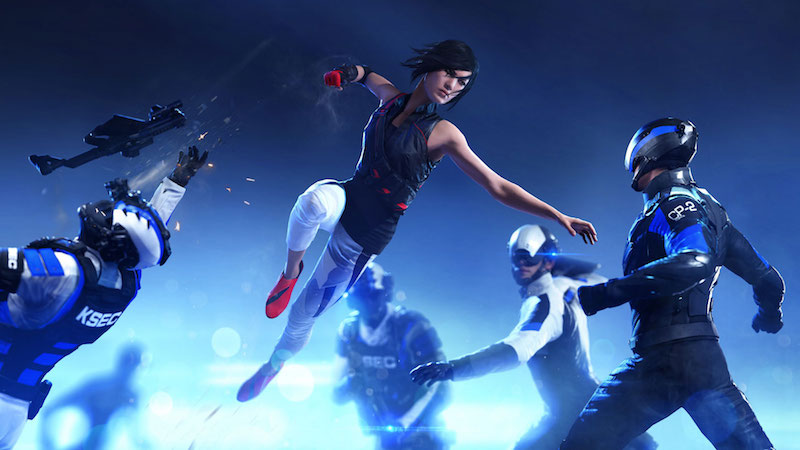
And the beta is absolutely not the real deal when it comes to kinks that need straightening out. Of course, this is all a first-impressions-only take on what Catalyst has to offer, a surface-level assessment, based on a small section of a much bigger game. Its more "realistic" design sees Catalyst lose that identity the first game gifted it – this isn't an escape into the unexpected, it's a slog through the suffocation of the already seen, in more routine first-person adventures. The first vista we're presented with isn't a rush of crisp cobalt it's a cloud-dotted sunset of oranges and purples, a skybox that looks pretty enough but, equally, is utterly unremarkable. Low-detail drones buzz in the sky, and futuristic cars bump awkwardly into each other on the roads below. But the uncomfortable impression left by this beta's early moments, those within the bland insides of a nameless building, isn't refined into anything more impressive when this city finally reveals itself from a lofty perspective. Or, better yet, combat becomes a significantly less important aspect of Catalyst. New on Motherboard: The 'Minecraft' Studio Made a Game That Isn't 'Minecraft' Cue: a loading screen that lasts for way too long considering these delivery missions – some of which are optional – are on timers counting down in seconds, not minutes. Reconnaissance tells Faith that there is some resistance between A and B. Now, the mission in question's objective is to deliver a package.

Not performing this move isn't an option likewise a little later in the beta, where Faith must take out a string of KrugerSec guys – KrugerSec being the big evil corporation at the heart of whatever evil drives the plot – at speed. Within minutes of Catalyst opening, I've swung across some scaffolding and kicked an unsuspecting guard through a pane of glass. In Mirror's Edge, Faith was no fighter, and certainly not a cold-blooded murderer. Forcefully kick one into another and they both stumble, losing health and buying you time to land a knockout blow, or simply run away from the encounter.

Then there's the "echoes", hard-light drones that she has to attack. As with the first game, the path of least resistance is always highlighted using red. This beta tutorial is set within internal environments, repetitive and grey, and sees Faith familiarise herself with wall running, swinging around conveniently protruding pipes and nailing ankle-preserving soft landings. Faith couldn't fight her way to the end, to her sister it was running that kept her alive. Nevertheless, it still felt special, different.

The freedom that a game built on the foundations of cityscape parkour could have offered was never realised, albeit at least partially because of the limited hardware of the time. Routes were predominantly linear, red lines streaked over sheets of white and veins of gold. (I already hate myself for writing that, but I hope you understand where I'm coming from.) It was a project, a product, which was effortless to appreciate for its ambition and aesthetics, its creative tenets but less easy to love, given its pervasive pernicketiness and swiftly shattered suggestion of an "open world". It was a game designer's game, I dare say, in the same way that you might hear a challenging, or innovative record sometimes referred to as being made by an "artist's artist". Guns weren't necessary, for the most part the bad guys used them, and you weren't a bad guy. From its outset, it underpinned its punishing performance demands with almost-certain death should your character, Faith, mistime a jump between rooftops. Stockholm's EA DICE produced a folly of a kind, a game without precedent a first-person platformer that primarily emphasised speed and elegance, combat avoidance over head-on collisions. Mirror's Edge was a raw diamond amongst a bounty of costume jewellery.


 0 kommentar(er)
0 kommentar(er)
